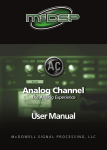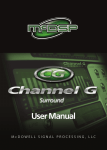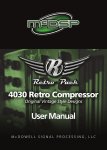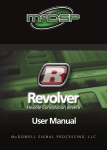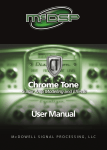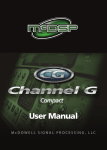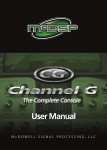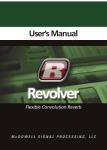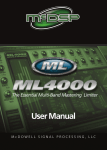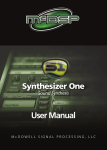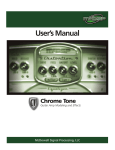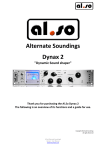Download User Manual
Transcript
DE555 Advanced De-essing User Manual McDOWELL SIGNAL PROCESSING, LLC McDSP DE555 De-esser Plug-In Manual McDSP McDowell Signal Processing, LLC 1300 Crittenden Lane #401 Mountain View, CA 94043 Support Email: [email protected] Technical Support: [email protected] World Wide Web: www.mcdsp.com Page ii McDSP DE555 Special Thanks to: • Rob Barrett Jr., our #1 customer • Richard Chycki - Thanks for the hospitality! • All those folks who asked for a de-esser from McDSP from the entire McDSP development team. Copyright Notice: Copyright 1998-2009 McDowell Signal Processing, Limited Liability Company All Rights Reserved. The McDowell Signal Processing, Limited Liability Company’s DE555 De-esser Plug-In and corresponding User’s Manual is copyrighted and all rights are reserved. Information in this document is subject to change without notice and does not represent a commitment on the part of McDowell Signal Processing, Limited Liability Company. This document may not, in whole or part, be copied, photocopied, reproduced, translated, or reduced to any electronic medium or machine-readable form for the purpose of resale without prior consent, in writing, from McDowell Signal Processing, Limited Liability Company. Trademarks: McDowell Signal Processing, Limited Liability Company is a trademark of McDowell Signal Processing, Limited Liability Company. Other brands and their products are trademarks of their respective holders and should be noted as such. Digidesign™ and Pro Tools™ are registered trademarks of Digidesign, Inc. mcdsp.com Page iii Table of Contents McDSP DE555 De-esser Plug-In Manual McDSP License Agreement Getting Started with DE555 Plug-In System Requirements Installing the DE555 Plug-In Installation on Mac OS X Installation on Windows XP Installation on VENUE D-SHOW systems Authorizing your McDSP Plug-Ins Authorizing with a pre-programmed iLok Smart Key Authorizing with an iLok License Card Authorizing with iLok.com Registering your McDSP Plug-In Using your McDSP Plug-Ins ii vi viii viii x x xii xiv xvi xvi xvi xx xxiii xxiii DE555 De-esser 1 The Quick Start Tour: The DE555 Plug-In 2 DE555 Overview Controls Key Filter De-esser Output Displays Meters Response Plots General Information Control Linking Automation Presets: Using the Presets and Making Your Own A Word on Preset Compatibility Page iv 3 5 5 5 5 6 6 6 7 7 7 7 7 McDSP DE555 Using the DE555 Plug-In Basics Key Filter Sibilance Reduction A Closer Look at the DE555 De-esser Problems Natural Sounding Sibilance Reduction Through Ratios DE555 Applications De-essing Dialog and Vocals Reducing Sibilance in Background or Group Vocal Tracks De-Breathing Reducing Guitar Fret Squeaks DE555 Plug-In Reference Guide Specifications DSP Delay DSP Usage HD and HD Accel DSP Hardware Maximum Instantiation Counts at 48kHz Percentage of DSP used by one instantiation at 48kHz mcdsp.com 8 8 8 8 9 9 10 10 10 11 11 11 12 12 13 13 13 13 13 Page v McDSP License Agreement The software described in this manual is furnished under a license agreement and may be used only in accordance with the terms of the agreement. McDowell Signal Processing, Limited Liability Company License and Warranty: The software which accompanies this license (the “Software”) is the property of McDowell Signal Processing, Limited Liability Company or its licensers and is protected by copyright law. While McDowell Signal Processing, Limited Liability Company continues to own the Software, you will have certain rights to use the Software after your acceptance of this license. Except as may be modified by a license addendum which accompanies this license, your rights and obligations with respect to the use of this Software are as follows: You May: • authorize 1 (one) copy of the Software on 1 (one) PACE Anti-Piracy iLok USB Smart Key, for use with no more than 1 (one) computer at any given time; • make copies of the Software for archival purposes, or copy the software onto the hard disk of your computer and retrain the original for archival purposes; • after written notice to McDowell Signal Processing, Limited Liability Company, transfer the Software on a permanent basis to another person or entity, provided that you retain no copies of the Software and the transferee agrees to the terms of this agreement You may not: • copy, duplicate, or reproduce the documentation which accompanies the Software for the purpose of resale; • sublicense, rent or lease any portion of the Software to a third party without expressed written permission from McDowell Signal Processing, LLC; • reverse engineer, de-compile, disassemble, modify, translate, make any attempt to discover the source code of the Software, or create derivative works from the Software; • make any attempt to circumvent any copy protection software; • use a previous version or copy of the Software after you have received a replacement set or an upgraded version as a replacement of the prior version, unless you donate a previous version of an upgraded version to a charity of your choice, and such charity agrees in writing that it will be the sole end user of the product , and that it will abide by the terms of this agreement. Unless you so donate a previous version of an upgraded version, upon upgrading the Software, all copies of the prior version must be destroyed. Page vi McDSP Limited Warranty: McDowell Signal Processing, Limited Liability Company warrants that the media on which the Software is distributed will be free from defects. Your sole remedy in the event of a breach of this warranty will be that McDowell Signal Processing, Limited Liability Company will, at its option, replace any defective media. McDowell Signal Processing, Limited Liability Company does not warrant that the Software will meet your requirements or that the operation of the Software will be uninterrupted or that the Software will be error-free. THE ABOVE WARRANTY IS EXCLUSIVE AND IN LIEU OF ALL OTHER WARRANTIES, WHETHER EXPRESSED OR IMPLIED, INCLUDING THE IMPLIED WARRANTIES OF MERCHANTABILITY, FITNESS FOR A PARTICULAR PURPOSE AND NON INFRINGEMENT. THIS WARRANTY GIVES YOU SPECIFIC LEGAL RIGHTS. YOU MAY HAVE OTHER RIGHTS, WHICH VARY FROM STATE TO STATE. Disclaimer of Damages: REGARDLESS OF WHETHER ANY REMEDY SET FORTH HEREIN FAILS OF ITS ESSENTIAL PURPOSE, IN NO EVENT WILL McDowell Signal Processing, Limited Liability Company BE LIABLE TO YOU FOR ANY SPECIAL, CONSEQUENTIAL, INDIRECT OR SIMILAR DAMAGES, INCLUDING ANY LOST PROFITS OR LOST DATA ARISING OUT OF THE USE OR INABILITY TO USE THE SOFTWARE EVEN IF McDowell Signal Processing, Limited Liability Company HAS BEEN ADVISED OF THE POSSIBILITY OF SUCH DAMAGES. SOME STATES DO NOT ALLOW THE LIMITATION OR EXCLUSION OF LIABILITY FOR INCIDENTAL OR CONSEQUENTIAL DAMAGES SO THE ABOVE LIMITATION OR EXCLUSION MAY NOT APPLY TO YOU. IN NO CASE SHALL McDowell Signal Processing, Limited Liability Company’s LIABILITY EXCEED THE PURCHASE PRICE FOR THE SOFTWARE. The disclaimers and limitations set forth above will apply regardless of whether you accept the Software. U.S. Government Restricted Rights: RESTRICTED RIGHTS LEGEND: Use, duplication, or disclosure by the Government is subject to restrictions as set forth in subparagraph (c) (1)(ii) of the Rights in Technical Data and Computer Software clause at DFARS 252.227-7013 or subparagraphs (c)(1) and (2) of the Commercial Software Restricted Rights clause at 48 CFR 52.227-19, as applicable, McDowell Signal Processing, Limited Liability Company, Mountain View, CA 94043 ([email protected]). General: This Agreement will be governed by the laws of the State of California. This Agreement may only be modified by a license addendum which accompanies this license or by a written document which has been signed both by you and McDowell Signal Processing, Limited Liability Company. Should you have any questions concerning this Agreement, or if you desire to contact McDowell Signal Processing, Limited Liability Company for any reason, please email: [email protected]. By downloading, using, or copying this Binary Software, Licensee agrees to abide by the intellectual property laws, and all other applicable laws of the U.S., and the terms of this License. Ownership of the software shall remain solely in McDowell Signal Processing, Limited Liability Company. mcdsp.com Page vii Getting Started with DE555 Plug-In Each McDSP plug-in is delivered inside an installer application, and uses the Interlok copy protection software to authorize each plug-in. This section describes how to install and authorize a McDSP plug-in. General system requirements are also described. System Requirements McDSP HD, Native, and LE plug-ins are compatible with Pro Tools™ HD, HD Accel TDM systems, as well as Pro Tools™ LE and Pro Tools™ M-Powered host based systems. McDSP plug-ins support Mac OS 10.4.x (Tiger), 10.5.x (Leopard), and Windows XP and require Pro Tools 7.x or greater. McDSP plug-ins require an iLok USB Smart Key. Configurations McDSP plug-ins are available in TDM, RTAS, and AudioSuite configurations. See individual products for specific available configuration sets. Applications Pro Tools™ 7.x or higher is required for TDM, LE, and M-Powered systems. Additionally, a third party software application that supports the Digidesign TDM, RTAS, or AudioSuite plug-in standard may be supported. See http://www. digidesign.com/developers/plugin_info/ for more information. McDSP plug-ins are compatible with the entire Pro Tools™ 7 product line. Hardware McDSP plug-ins support any Digidesign or approved third party hardware supported in Pro Tools™ 7.x. This includes HD, HD Accel, 003, and Mbox host based systems. All McDSP HD plug-ins, except Chrome Tone and Synthesizer One, also support the Digidesign VENUE D-SHOW systems. See http://www. digidesign.com/compato/ for more specific information. The McDSP Mac versions are compatible with both Intel and PowerPC based computers. The McDSP XP versions require an Intel Pentium 4 or greater processor.* Page viii Getting Started * Our XP test machines are chosen to follow the Digidesign recommended systems guide, which currently is the Dell Precision™ Workstation 670 with 2.79 GHz Xeon processor. All products are guaranteed to run on that system. Older Intel processors (i.e. Pentium III and predecessors) and AMD processors are not officially supported, although some users have had limited success with newer AMD processors (i.e. Dual Opteron 1.79 GHZ, Athlon 64 2.20 GHz, and Athlon 64 XP 3700). None of our XP product line will work with Pro Tools™ 5.x. Also note that our XP product line does not support MIX, although RTAS versions will work if they exist and the rest of your system (i.e. Pro Tools™ version and processor) is compatible. Please visit mcdsp.com for the latest information about compatibility. mcdsp.com Page ix Installing the DE555 Plug-In Installation on Mac OS X The DE555 plug-in Package includes this manual, ReadMe and Release Notes, a folder of presets for the DE555 plug-in, and the DE555 plug-in. Two copies of the DE555 Licensing Agreement are included - one in this pdf manual and a second as a separate text file. The DE555 plug-in manual requires that Adobe Acrobat reader (or similar .pdf reader) is installed. Both online and boxed version will come with a DE555 installer that will automatically install the DE555 plug-in and its presets on your system. The authorization of the DE555 plug-in is still required after running the installer, and those steps are detailed in the following sections. Installing the DE555 plug-in and presets with the Installer: The online version of the package has been prepared for Internet delivery, and is transmitted as a compressed file in zip format (.zip). In Mac OS X 10.4.x or 10.5.x, simply double click the *.zip file to unpack the installer. The boxed plugin package purchased at your local dealer will be on CDROM. As with the online version, these ‘physical’ versions of the DE555 plug-in package should be copied into a local folder on your system. • Insert the McDSP ‘HD Disk,’ ‘Native Disk,’ or ‘LE Disk’ CDROM onto an available CDROM drive. • Navigate to the DE555 plug-in folder on the CDROM - the installer application is contained therein. • Run the DE555 plug-in Installer application to install (copy) the DE555 plug-in, presets, and documentation to a local folder on your system. The plug-in will be placed in the ‘Plug-Ins’ folder, and the presets will be placed in the ‘PlugIns Settings’ folder. • If a previous version of the DE555 plug-in (or other HD, Native, or LE version) was already in the plug-ins folder, it will automatically be updated (or replaced) by the installer. Page x Getting Started Re-installing the DE555 plug-in presets manually: In you wish to restore the factory default presets, it may be useful to know how to manually re-install only the presets. • Go to the ‘Plug-in Settings’ folder: • Root->Library->Application Support->Digidesign->Plug-in Settings • If Pro Tools™ has not already done so for you, create a folder called ‘DE555’. • Place a copy of the folder from the DE555 plug-in package called ‘Presets’ into the ‘DE555’ folder. The presets are now viewable (after restarting Pro Tools™) from the settings popup menu from the DE555 plug-in. Note it may be necessary to re-start Pro Tools™ in order for the newly added ‘Presets’ folder to be viewable from the Settings popup inside the DE555 plug-in window toolbar. mcdsp.com Page xi Installation on Windows XP The DE555 plug-in Package includes this manual, ReadMe and Release Notes, a folder of presets for the DE555 plug-in, and the DE555 plug-in. Two copies of the DE555 Licensing Agreement are included - one in this pdf manual and a second as a separate text file. The DE555 manual requires that Adobe Acrobat reader (or similar .pdf reader) is installed. Both online and boxed version will come with a DE555 installer that will automatically install the DE555 plug-in and its presets on your system. The authorization of the DE555 plug-in is still required after running the installer, and those steps are detailed in the following sections. Installing the DE555 plug-in and presets with the Installer: The DE555 plug-in package purchased at your local dealer will be on CDROM and contain a Windows self extracting executable (.exe) similar to the online DE555 plug-in package prepared for Internet delivery. Both the boxed and online versions the DE555 plug-in executable file will automatically install the plug-in and its presets on your system. Double click the file to launch the installer which will install the DE555 plug-in, presets, and documentation. At any time after installation, you may access the documentation from the Windows ‘Start Menu’ under the ‘McDSP’ group. Authorization of the DE555 plug-in is still required after running the installer, and those steps are detailed in the following sections. Note that after installing new versions of the PACE iLok drivers with the DE555 plug-in installer, you will be prompted by the DE555 plug-in installer to reboot your system. If you are not prompted by the installer, there is no need to reboot. • Insert the McDSP ‘HD Disk,’ ‘Native Disk,’ or ‘LE Disk’ CDROM onto an available CDROM drive. • Navigate to the DE555 plug-in folder on the CDROM - the installer application is contained therein. • Run the DE555 plug-in Installer application to install the DE555 plug-in, presets, and documentation to a local folder on your system. The plug-in will be placed in the ‘Plug-Ins’ folder, and the presets will be placed in the ‘PlugIns Settings’ folder. • If a previous version of the DE555 plug-in (or other HD, Native, or LE version) was already in the plug-ins folder, it will automatically be updated (or replaced) by the installer. Page xii Getting Started Re-installing the DE555 plug-in presets manually: In you wish to restore the factory default presets, it may be useful to know how to manually re-install only the presets. • Go to the Plug-In Settings folder: • C:\Program Files\Common Files\Digidesign\DAE\Plug-In Settings\ • If Pro Tools™ has not already done so for you, create a folder called ‘DE555’. • Place a copy of the folder from the DE555 plug-in package called ‘Presets’ into the ‘DE555’ folder. The presets are now viewable (after restarting Pro Tools™) from the settings popup menu from the DE555 plug-in. Note it may be necessary to re-start Pro Tools™ in order for the newly added ‘Presets’ folder to be viewable from the Settings popup inside the DE555 plug-in window toolbar. mcdsp.com Page xiii Installation on VENUE D-SHOW systems The DE555 plug-in Package for VENUE D-SHOW systems includes presets for the DE555 plug-in and the DE555 plug-in. The DE555 Licensing Agreement is displayed when installing the product on D-SHOW. The pdf manual can be obtained by running the Mac OS X or Windows XP version of the DE555 Pro Tools plug-in installer on any available computer. Both online and boxed versions will come with a VENUE compatible installer that will automatically install the DE555 plug-in and its presets on your system. The authorization of the DE555 plug-in is still required after running the installer, and those steps are detailed in the following sections. All McDSP HD plug-ins, except Chrome Tone and Synthesizer One, also support the Digidesign VENUE D-SHOW systems. Installing the DE555 plug-in and presets on VENUE with the ‘HD Disk’: The boxed DE555 plug-in package purchased at your local dealer will contain a CDROM titled ‘HD Disk’ that is specially formatted to work with your VENUE console. The VENUE installers are also available online as a compressed zip file download, however you will have to take additional steps to create your own VENUE installer CD-R, see additional instructions below before proceeding with these instructions. Both the boxed and online versions of the DE555 installer are the same and will install both the plug-in and its presets on your system. Note that after installing new versions of the PACE iLok drivers with the DE555 plug-in installer, you will need to reboot your system. You will not be prompted to reboot, and if you don’t you may see an error message saying “TPkd driver required, and a reboot. Please reboot or reinstall the software.’ If you see this message, simply reboot the console and try again. • Insert the McDSP ‘HD Disk’ CDROM onto the CD drive. Note that neither the McDSP ‘Native Disk’ nor the ‘LE Disk’ contains VENUE compatible installers. • Ensure your system is in ‘CONFIG’ mode, you cannot install plug-ins in ‘SHOW’ mode. • Navigate to the ‘OPTIONS’ page and then select the ‘PLUG-INS’ tab. • You should now see the DE555 plug-in available on the left hand side. • Select the DE555 plug-in and select ‘INSTALL.’ • If a previous version of the DE555 plug-in was already installed, it will be updated by the installer. Page xiv Getting Started Important note for FilterBank HD and CompressorBank HD on VENUE D-SHOW consoles: The first time you instantiate either of these plugins, a dialog box will appear asking you to choose a user interface preference. Choose the Knobs interfaces, as some of the Slider interfaces are too large for the VENUE display. Creating a VENUE D-SHOW Installer CD-R from the online zip file: If you do not have a boxed copy of DE555 with the included ‘HD Disk’ CDROM, you can still obtain a copy of the VENUE compatible installers from the www. mcdsp.com website. Once you have located and downloaded the latest VENUE compatible installers from the McDSP website, you will have to take several additional steps to create a VENUE compatible Installer CD-R. For your convenience, all VENUE compatible products are located in the same downloadable zip file, so you will only have to create one CD-R to install all compatible McDSP products. • Unzip the downloaded file and locate the folder named “TDM Plug-Ins” inside the unpacked folder. • Using any CD-R burning application, burn this folder and its contents to an ISO format CD-R. It is recommended that you use a brand new CD-R for this, and do not rewrite an older CD-R. • Once you have burned this folder to a CD-R, you should see it at the root level of the disk (i.e. “D:\TDM Plug-Ins”). Important: If the “TDM Plug-Ins” folder is not located at the root level of the CD-R or has been renamed, the VENUE console may not properly recognize the installer disk. • At this point, you can follow the ‘HD Disk’ installation instructions above to complete the installation. mcdsp.com Page xv Authorizing your McDSP Plug-Ins Authorizing with a pre-programmed iLok Smart Key McDSP bundles such as the Emerald Pack come with a pre-programmed iLok Smart Key. Simply insert the iLok into any available USB port on your computer. The iLok’s indicator light will illuminate when the iLok has a proper connection. The Plug-Ins included in the bundle require no further authorization steps. As with any iLok on your system it is recommended that your iLok be registered and synchronized with iLok.com Authorizing with an iLok License Card All McDSP Plug-Ins require that a valid authorization is present on your iLok USB Smart Key. McDSP Plug-ins that are purchased individually provide this authorization on a plastic License Card (about the size of a credit card), with a small punch-out iLok License Chip. After being separated from the License Card, this iLok License Chip is to be inserted into the ‘key slot’ of the iLok USB Smart Key in order to transfer the authorization from the License Card to the iLok USB Smart Key. Note that each License Card holds ONE Plug-In authorization. The following instructions detail this process Important Note: The Authorization Wizard will prompt the user to register their iLok USB Smart Key at iLok.com. iLok.com is a service offered by PACE Anti-Piracy, Inc. and this step is recommended but NOT REQUIRED by McDSP to complete the authorization of the Plug-In. If you choose to register your iLok USB Smart Key at iLok.com, care must be taken to record your ilok.com account information (i.e. write down your User ID and Password in a safe place). If your iLok.com account information is lost, the iLok cannot be registered to another account and unfortunately there is nothing McDSP can do to help you. See iLok. com for more details about the benefits of using PACE’s iLok.com service. Note: Images in this section are for illustration only, the actual product and screens will be the name of the product you are authorizing. Page xvi Authorizing Your McDSP Plug-Ins Authorizing a McDSP Plug-In from a License Card with the Authorization Wizard: The Authorization Wizard is used to install an authorization from a License Card to the iLok USB Smart Key. To use the Authorization Wizard for the Plug-In you purchase, perform the following steps: • Insert your iLok USB Smart Key into an available USB port. • On a Mac :Locate and launch the ‘Authorizer’ application found in the ‘Authorize’ folder in the Plug-In package for the McDSP Plug-In you purchased on the CD-ROM. • On Windows XP or Vista, just launch Pro Tools™ to authorize the individual McDSP Plug-In you purchased. Note: When authorizing the Plug-In on Windows XP or Vista with a new iLok USB Smart Key, you must insert the iLok USB Smart Key and complete the Windows ‘Found New Hardware Wizard’ before attempting to authorize the Plug-In. • Select the ‘Authorize’ button to be guided through the Authorization Wizard. Note: Selecting the ‘Quit’ button at any time will not authorize the Plug-In or allow it to be used for a trial period. If ‘Quit’ is selected, the Plug-In will not be available in the Pro Tools™ insert menu. • McDSP Plug-Ins require that the user personalize their copy of the Plug-In. A dialog is displayed soliciting this information. Note that the product registration card enclosed with the Plug-In MUST ALSO be filled out as well and returned to McDSP via mail (or fax to 707-2200994). This additional mail-in registration will entitle the user to future upgrades and advance information from McDSP. mcdsp.com Page xvii • Once the Plug-In is personalized, click the ‘Next’ button to continue. • Check the ‘Use License Card’ box and press the ‘Next’ button (figure 2.3). Note: Although the Authorization Wizard may appear to allow authorization by challenge/ response, that method is currently NOT SUPPORTED McDSP Plug-Ins. • Separate the small punch-out iLok License Chip (the removable metal and plastic tab) from the License Card by pushing the cutout up and out with your thumb. Do not force your finger downward. • The iLok License Chip may now be inserted into the ‘key slot’ of the iLok USB Smart Key (figure 2.6). If the iLok USB Smart Key does not appear to be present on the system, ensure the iLok USB Smart Key is connected to a valid USB port and that the green LED is lit inside the iLok USB Smart Key. To insert the License Chip into the iLok USB Smart Key, orient the iLok USB Smart Key’s USB end to the left, and the loop end to the upper right. Insert the metal chip end of the iLok License Chip (the License Chip tab should have the metal chip side facing up towards you, not down). You should be able to visually verify that the License Chip makes contact with the iLok USB Smart Key metal card reader. • The green LED in the iLok USB Smart Key will light when it is ready to receive and transmit data. • Upon inserting the iLok License Chip, a message will be displayed indicating the authorization was installed successfully. Click ‘Ok’ in the message dialog. Page xviii Authorizing Your McDSP Plug-Ins • Once the authorization is installed on the iLok USB Smart Key, a dialog is displayed prompting the user to register their iLok USB Smart Key at the www.ilok.com website. The iLok.com website was created to allow users to manage the software authorizations on their iLok USB Smart Key. THIS STEP IS NOT REQUIRED TO COMPLETE THE AUTHORIZATION OF MCDSP SOFTWARE. The registration of the iLok USB Smart Key to an iLok.com account can be bypassed by clearing the checkbox. The user may also choose to not be asked to register again. While iLok.com is a great resource for the iLok USB Smart Key, your iLok USB Smart Key may only be linked to one iLok.com account. That is, an individual iLok USB Smart Key can only be registered to one account at a time--but a single account can have multiple iLok USB Smart Keys. If the iLok.com account information is lost, the iLok USB Smart Key cannot be registered to another account. However, an iLok USB Smart Key may be transferred between accounts if all the authorizations have been transferred off the iLok USB Smart Key. Register the iLok USB Smart Key to an iLok.com account only when you are ready to retain all the needed iLok.com account information (User ID and Password). • A ‘Finished’ dialog is displayed showing what authorization method was used. • Click ‘Finish’ to exit the Authorization Wizard. mcdsp.com Page xix Authorizing with iLok.com Required for demo, upgrade, and replacement authorizations only iLok.com can be accessed from any Macintosh or PC with an Internet connection. You can do this at home, a friend’s, or at the office as long as there is an internet connection to access iLok.com--note that you don’t have to use your ProTools system computer! You simply use this computer to connect to iLok.com and transfer authorizations to your iLok Smart Key. The iLok Smart Key can then be moved to your ProTools system to complete authorization of your Plug-In. You will need: • A computer with an Internet connection. Either a Macintosh running OS 9.2 to OS 10.3 or a PC running Windows 98, ME, 2000, XP, or Vista • An iLok USB Smart Key • A valid iLok.com account. Visit www.iLok.com and set up a free account, if you have not already done so. 1) Download and install the required client software from iLok.com. 2) Download the desired McDSP Plug-In Installer from: http://www.mcdsp.com/support/updating.html 3) To receive an upgrade or replacement authorization, send email your iLok. com account information to: [email protected] To receive a demo authorization, email your iLok.com account information to: [email protected] Insert your iLok Smart Key into an available USB port and ensure that the indicator light is lit. Once your demo, upgrade, or replacement authorization is available for transfer, your iLok.com account will display the notice saying “You have licenses” on the upper left. Begin by selecting that link. Page xx Authorizing Your McDSP Plug-Ins The next page will display the pending licenses available for download. This page will also display the name of the Plug-In, its manufacturer, the type of authorization (demo, Not For Resale, or License), the date the authorization was deposited, and the date when the authorization will no longer be available for download from the server. Before any transfer of authorizations can take place, you must synchonize your iLok Smart Key with iLok. com. This may take a moment to process depending on your internet connection. Once you have synchronized your iLok, you can select the authorization(s) you wish to transfer to your iLok. If you have multiple iLoks connected to your computer, it is important to select the correct iLok you wish the authorizations to be transferred to. Then click “Download Licenses” to begin the process. Again, this may take a moment depending on your internet connection. When the transfer finishes you will be asked to confirm the completition of the transaction, thereby letting you know that the transfer was successful. mcdsp.com Page xxi If you wish to go back into your account and visually confirm the transaction for yourself, select “View iLoks” Then select the iLok you had the authorizations transferred to. That’s it! Dont forget to logout and move the iLok Smart Key to your ProTools System if you are using another computer for Internet access. Also, you may need to install a different version of the Plug-In if you are upgrading or replacing. Transferring Authorizations with iLok.com You may freely transfer any authorization within your iLok.com account between any of your registered iLok Smart Keys. If you wish to transfer an authorization out of your iLok.com account to a different user, it will require additional support from PACE Anti-Piracy, Inc and may be subject to a service fee or limited by manufacturer restrictions. Check the www.ilok.com website for updates and developments regarding iLok USB Smart Keys and the Pace Interlok Copy Protection system. Page xxii Authorizing Your McDSP Plug-Ins Registering your McDSP Plug-In To register your McDSP Plug-In, fill out and return the product registration card enclosed with the boxed Plug-In package by mail or fax 707-220-0994. Registering your product entitles you to future upgrades and advance information from McDSP. Each individual product must be registered (even if you have multiple copies), and the product must be registered to an individual, not an entity. If you represent a company it is your company’s responsibility to notify McDSP in writing if the individual who registered the Plug-In is no longer with the company. The Company must also be able to supply matching registration information to successfully transfer ownership of the Plug-In. Using your McDSP Plug-Ins Starting a McDSP Plug-In: Follow the installation, authorization, and registration instructions above, Launch Pro Tools™, and the McDSP Plug-In and its presets are ready for use. Refer to the Digidesign™ Pro Tools™ Reference Guide for details on general Plug-In operation such as automation. Exiting a McDSP Plug-In A McDSP Plug-In is exited by clicking on the desktop or other window in the DAE application running the Plug-In, closing the Plug-In window, or de-instantiating the Plug-In. Pro Tools™ sessions will save instantiated Plug-In configurations and their settings. Refer to the Digidesign™ Pro Tools™ Reference Guide for details on general Plug-In operation. Digidesign™ and Pro Tools™ are registered trademarks of Digidesign, Inc. mcdsp.com Page xxiii McDSP DE555 DE555 De-esser The DE555 De-esser is a new generation of de-essing technology, providing transparent, precise de-essing with unique flexibility. The DE555 De-esser represents new advancements in the art of removing voiced sibilance from vocal and dialog tracks. Traditional De-essers rely on signal level to process and reduce vocal/dialog sibilance, causing the user to continually adjust sensitivity controls (such as an input threshold level) to provide consistent deessing performance. The DE555 uses a new approach, combined with look-ahead technology, for consistent, transparent, natural sounding de-essing at any signal level. Other options include continuously adjustable ratio and release controls to finetune the de-essing amount, plus a high frequency (HF) only mode for reducing the signal level of only the ‘sss’ and not the original dialog. Key filter options include high pass and band pass filtering. A unique focus control further enhances the key filter’s ability to separate ‘essing’ from actual dialog. The key filter output can also be monitored. Real-time displays of de-essing amounts and key filter response enable quick and easy setup. Features: • Advanced de-essing technology • Unique key filter focus and de-essing controls • Real-time metering and key filter response plot • High frequency (HF) only option • Double precision processing • Low Latency • Mono and stereo versions • Supports up to 96 kHz sample rates mcdsp.com Page 1 The Quick Start Tour: The DE555 Plug-In Start Pro Tools™ and Instantiate the DE555 plug-in • Launch Pro Tools™ and Open a Pro Tools™ Session. • Verify the Display-> Mix Window Shows->Inserts View option is checked. • In one of the inserts of a stereo master fader, select the DE555 plug-in. Note the DE555 plug-in will operate on master or regular audio tracks in mono or stereo versions. • If the insert selection does not show the DE555 plug-in, verify that the DE555 plug-in has been installed correctly. • For more information on starting Pro Tools™ and working with Plug-ins, see Digidesign’s™ Pro Tools™ Reference Guide Page 2 McDSP DE555 DE555 Overview The DE555 De-esser uses a new approach to effectively remove sibilance from vocal and dialog tracks. The controls, however, are much like those found on any ordinary de-esser (minus a threshold control). The Key Filter section selects what portion of the audio spectrum will be treated as sibilant events. The Filter Type, Frequency, and Focus controls setup the filter shape, and the filter output can be monitored. The de-essing amount is determined by the Range control, and further fine-tuned by the Ratio, Release, and HF mode controls. Output levels are set by the Output control. The Frequency Response plot shows the amount of de-essing across the entire frequency range in realtime, and the input, output, and reduction meters also show de-essing activity and signal levels. mcdsp.com Page 3 Key Filter De-esser Output Isolates sibilant events that trigger the de-esser Controls amount of sibilant reduction Sets overall level of de-essed signal Page 4 Plot Meters Shows Key Filter response and de-essing activity Realtime display of input and output levels, plus amount of de-essing McDSP DE555 Controls Key Filter The Key Filter is used to identify and isolate sibilant events, and feed this processed signal into the deesser. • Freq – key filter frequency • Focus - key filter shape control to augment and further define de-essing events in the key filter • Filter Type - high pass and band pass filtering options • Listen - monitor the output of the key filter to isolate de-essing events De-esser The De-esser reduces the signal level of the sibilant event identified by the Key Filter. • Range - amount of de-essing (up to 36 dB) • Ratio - slope, or ‘strength’ of de-esser - low ratios provide gentle de-essing, high ratios provide greater de-essing • Release - recover time from each de-essing event • HF Only - de-essing only applied to high frequency data, at and above the key filter frequency Output The Output section provides a final signal level adjustment of the de-essed audio. • Level – output signal level adjustment (-24 to +24 dB) mcdsp.com Page 5 Displays Meters The DE555 de-esser has meters showing input signal output signal levels, as well as de-essing amount. These meters also can be used to confirm relative input and output levels are the same during the deessing events, and monitor de-essing activity. Response Plots The Frequency Response/Key plot shows not only the shape and location of the Key Filter, it also draws a dynamic plot as de-essing occurs. If the HF Only mode is selected, this dynamic plot will show where the high frequencies are reduced by the de-esser. The Dynamics plot shows the compressor-like curve response of the de-esser. The Ratio and Range controls affect the shape of this curve. Page 6 McDSP DE555 General Information To adjust any of the DE555 controls the user can: • Hold the <Command> key while dragging the slider for fine control, or • Click on the text box to highlight and edit the numeric value to get precise control (if a value outside the valid range is input, the control will default to the nearest allowed value when enter is hit) and hit <Enter>, or • Click on the text box to highlight the numeric value and then use the arrow keys to increase or decrease the numeric value, or • Use the <Option> key to bring all the controls to their default values, or • Use hardware controller surfaces supported by the NF575 plug-in including the Mackie HUI and Digidesign’s ICON™, ProControl™ and Control 24. Control Linking There is no control linking available in the DE555 De-esser plug-in at this time. Automation All DE555 De-esser controls are completely automatable. See the Digidesign™ Pro Tools™ Reference Guide, Automating Plug-ins section. Presets: Using the Presets and Making Your Own The DE555 De-esser preset library demonstrates the wide range of applications the DE555 can be used. No preset will suit every application, and they have been provided as a guide for the user, and will hopefully inspire new ideas and ways to use this sophisticated plug-in. The presets can be accessed from the Pro Tools™ “Plug-in Librarian” and “Plugin Settings” pop-up menus. To make and save your own presets, see the “Plug-in Librarian Functions” section of Digidesign™‘s DigiRack Plug-ins Guide. A Word on Preset Compatibility Presets for the DE555 De-esser configurations are interchangeable. Pro Tools™ is a registered trademark of Digidesign, Inc. mcdsp.com Page 7 Using the DE555 Plug-In The DE555 De-esser plug-in provides an effective, efficient method for reducing sibilance in vocal and dialog tracks. The following sections cover basic operations of the algorithms in the DE555 De-esser, provide a more in depth description of some of the features of the DE555, and outline some applications of the DE555 plug-in. Basics A de-esser can be broken down into two parts - key filter and sibilance reduction. Key Filter In order to reduce sibilance, the de-esser must isolate that portion of the signal from the rest of the vocal/dialog. The DE555 uses a high pass or band pass filter to accomplish this task. High pass filters remove signal below the selected frequency, and pass the signal above the selected frequency unaffected (hence the term high pass). Band pass filters only pass signal at the exact selected frequency. Signal levels are reduced for frequencies above and below the selected frequency. This process is taken to the next level by providing a focus control to adjust high pass filter resonance or band pass filter bandwidth. This makes the filter more selective in determining what signals pass the filter, and also what frequencies are actual increased in level. This additional emphasis on ‘essing’ event allows more effective de-essing. The key filter output can be monitored to find precise settings best suited for the vocal or dialog track being processing. Sibilance Reduction Once an adequate signal is created that identifies the sibilance events from the rest of the vocal or dialog, a signal reduction algorithm is used to reduce the level of these events by a selected amount. Operating much like a compressor, the sibilance reduction process will reduce signal levels at a prescribed attack and release (recovery) time, to a selected maximum. The Ratio control on the DE555 determines the strength of the de-essing action. Again like a compressor, a low ratio value yields gentle or natural sounding Page 8 McDSP DE555 de-essing, while a greater ratio produces a stronger effect (more signal level is reduced). Both low and high ratio values are needed for different applications. The Release control on the DE555 determines at what rate the de-essing action recovers, or no longer continues to affect the signal. Ideally the de-esser should have a very fast attack and release time, but such settings on a regular compressor (or simpler de-esser) produce a great deal of distortion. The DE555 can have release times as fast as 1 msec without producing any audible distortion. Some de-essers, like the DE555, have a high-frequency only mode (HF Only) that causes the de-esser to only de-ess frequencies at and above the key filter frequency. The HF-Only mode is useful for creating a more natural de-essing sound. A Closer Look at the DE555 De-esser Problems Because the sibilance reduction operates much like a compressor - triggering events occur that cause the algorithm to respond at a prescribed rate, several problems can (and do) occur. The problem with this process is fast attack/ release times can introduce distortion into the audio. But unless attack and release times are not fast enough, the sibilance event may be missed (not reduced enough, if at all), or the rest of the dialog or vocal is reduced too much. Furthermore, often the sibilance reduction does not sound natural if all signal frequencies are reduced during the sibilance event. On top of these problems, sibilance and vocal/dialog levels can vary considerable (even if pre-compressed), forcing the continuous adjustment (or automation) a traditional de-esser input threshold. The DE555 De-esser address all these problems. Using technology from the award winning ML4000 mastering limiter and multi-band dynamics processor, the DE555 attack and release times are extremely fast, and yet do not introduce any distortion into the audio path. A HF Only mode is provided for instances when only reducing the high frequency signal content is needed during sibilance events. And finally, the input signal level is NOT used to trigger de-essing action. Instead, an advanced algorithm allows the DE555 to de-ess consistently at any signal level. For example, if a portion of the dialog was at -24 dB (a whisper), and later at -2 dB (a shout), the DE555 would still only de-ess the amount given by its Range and Ratio controls. This advancement reduces time spent adjusting (or automating) threshold dependent controls found on other de-essers. mcdsp.com Page 9 Natural Sounding Sibilance Reduction Through Ratios The challenge of good de-essing is to remove sibilance while retaining a natural sound in the vocal or dialog. Overly used de-essing processing makes the track sound unnatural, and can even give the singer/speaker a lisp! For this reason the DE555 includes a ratio control. Gentle, or natural sounding de-essing can be accomplished using lower ratios like 2:1 and 4:1, while strong de-essing can be done using higher ratios (10:1, 20:1). Note how the maximum amount of de-essing, given by the Range control, remains fixed, so the user can still obtain a selectable amount of de-essing even as the Ratio control is adjusted. DE555 Applications De-essing Dialog and Vocals The process of setting up a de-esser can be summed in with these steps: • Enable monitoring of the Key Filter, and start playback over a short piece of audio with some sibilance • Adjust the Key Filter Frequency control until just the ‘essing’ events pass the filter, leaving the rest of the dialog or vocal mostly filtered. Experiment with the high pass filter and band pass filter options during this step. • Increase the Focus control to either emphasize the high pass filter output, or narrow the selectivity of the band pass filter. • Disable key filter monitoring, and move on to the De-esser controls. • Adjust the Range control for the amount of de-essing. Usually 6 to 9 dB is natural, although higher settings can produce good results too. Be sure not to overdo it, else you will give the singer/speaker a lisp! • The Ratio control determines the amount of de-essing as stronger ‘essing’ events occur (like a compressor ratio control). Settings of 2:1 to 4:1 are usually enough, and 10:1 to 20:1 are for more drastic de-essing. • The Release control should be as fast as possible, however sometime a slower setting can make the processed track sound more natural. • Note the combination of Range, Ratio, and Release make up the ‘sound’ of the de-esser - smaller ranges with larger ratios, larger ranges with smaller ratios, larger/smaller ranges with faster/slower release times, etc. Page 10 McDSP DE555 • Finally, the Output control can insure the vocal or dialog is at roughly the same level after being processed. This control is seldom needed, but useful in a pinch. Reducing Sibilance in Background or Group Vocal Tracks Just as the main vocal track can require de-essing, the background vocals often have the same issues. Many singers belting out some phrases can only further emphasize ‘essing’ events. And when the lead singer and background singers are not entirely in sync (or even when they are), the sibilance of the background vocals should not distract from the main vocal. More aggressive de-essing settings for background vocals allow the lead vocal to stand out more, as the lead vocalist articulation comes out, while the background vocals remain, well, in the background. De-Breathing Like ‘essing’ events, a vocal or dialog track can contain the inhales of the singer/ speaker before each phrase is belted out. Often a gate, like the one on Channel G is great for removing this unwanted audio, but sometimes this audio is to be included in the production. For example, if the actor in the movie takes a big breath before he kisses the girl goodnight, the audience will expect to hear that inhale. Use the de-esser to soften that sound if it proves to be a bit too loud. Reducing Guitar Fret Squeaks Vocals are not the only kind of audio that may contain unwanted high frequency events. Fret squeaks produced by the guitar player (electric or acoustic) can be reduced using a de-esser. The same tips apply as when de-essing a vocal or dialog track - too much can sound unnatural - so don’t overdo it. mcdsp.com Page 11 DE555 Plug-In Reference Guide Specifications Parameter Range Function FREQ 500Hz to 15kHz Key Filter frequency FOCUS 0 to 100% Key filter shape control to augment and further define deessing events in the key filter FILTER TYPE HIGH PASS/ BAND PASS Filtering options LISTEN OFF/ON Monitor the output of the key filter to isolate de-essing events RANGE 0 to -36 dB Amount of de-essing RATIO 2.0 to 20.0 Slope, or ‘strength’ of De-esser RELEASE 1 to 100msec Recover time from each de-essing event HF ONLY OFF/ON De-essing only applied to high frequency data, at and above the key filter frequency -24 to +24 dB Output signal level adjustment KEY FILTER De-esser OUTPUT LEVEL Page 12 McDSP DE555 DSP Delay The DE555 plug-in uses a short look-ahead delay of roughly 1 msec. The total dsp delay using the DE555 plug-in is 55 samples at 48kHz sample rate. DSP Usage HD and HD Accel DSP Hardware The TDM versions of the DE555 plug-in configurations use a varying amount of DSP resources for each DE555 plug-in configuration. The table below is a listing of these DSP usages. DSP usage is shown in the Pro Tools™ System Usage window. Maximum Instantiation Counts at 48kHz Configuration DE555 Mono DE555 Stereo # Instantiations per DSP on HD systems 3 2 # Instantiations per DSP on HD Accel systems 6 5 All of the DE555 plug-in configurations can operate on the same DSP, depending on the configuration’s DSP requirements. See below for the percentages of a HD or HD Accel DSP used by a single instantiation of a DE555 plug-in. Percentage of DSP used by one instantiation at 48kHz Configuration DE555 Mono DE555 Stereo % of DSP Used on HD systems 29% 38% % of DSP Used on HD Accel systems 15% 19% The DE555 plug-in supports some higher sample rates (88.2 kHz and 96 kHz). An HD Accel card is required to run the DE555 plug-in at 88.2 kHz or 96 kHz. For 88.2 kHz and 96 kHz operation the dsp usage is roughly two and a half times great (2.5x) mcdsp.com Page 13 www.mcdsp.com Copyright 2009 by McDowell Signal Processing,LLC. All trademarks are property of their respective owners. McDSP is a trademark of McDowell Signal Processing,LLC.





































